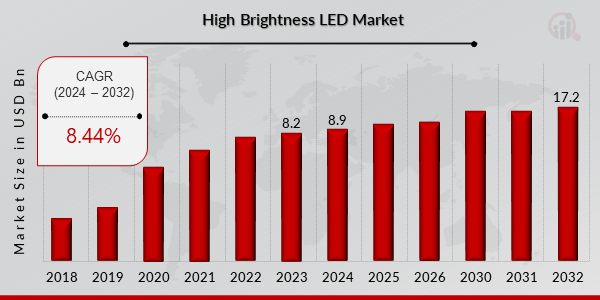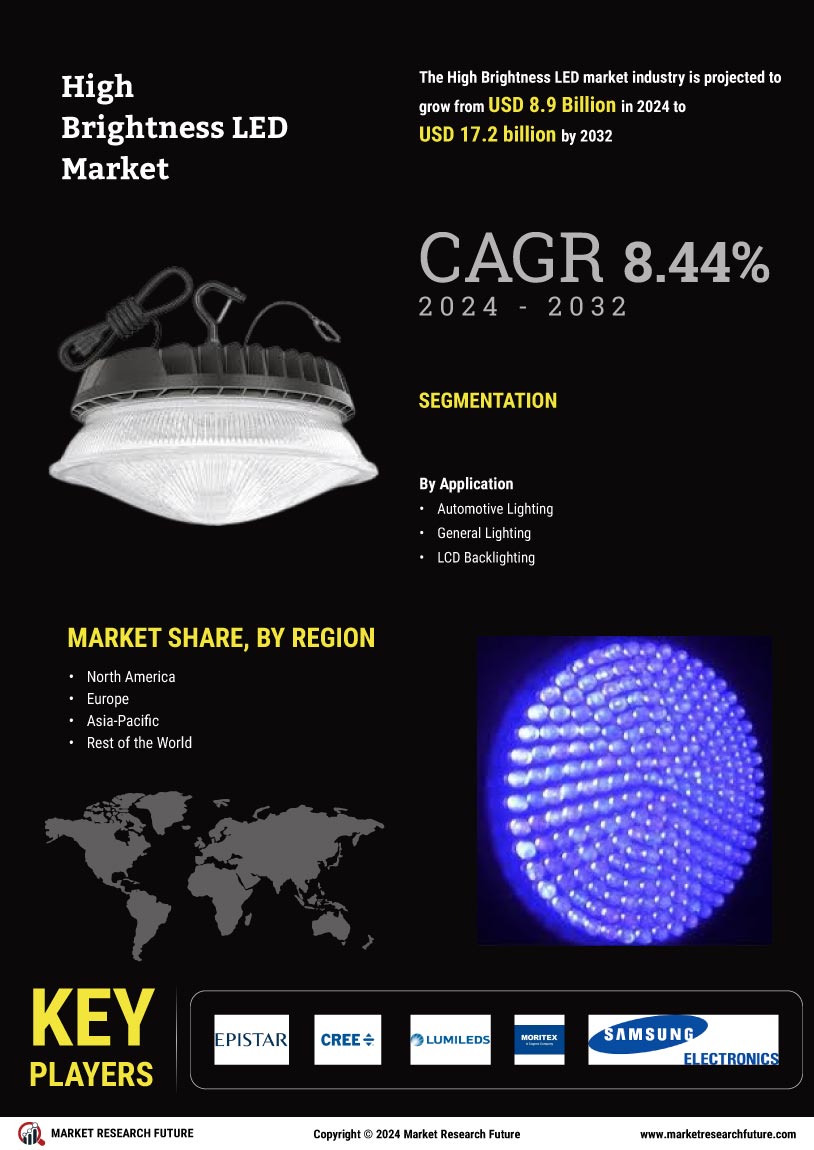Global High Brightness LED Market Overview:
High Brightness LED Market Size was valued at USD 8.2 Billion in 2023. The High Brightness LED market industry is projected to grow from USD 8.9 Billion in 2024 to USD 17.2 billion by 2032, exhibiting a compound annual growth rate (CAGR) of 8.44% during the forecast period (2024 - 2032). Buildings are anticipated to embrace LED lighting more frequently as environmental concerns grow. The demand for LED lights in general illumination is anticipated to expand significantly, contributing to the market drivers and enhancing market growth.

Source: Secondary Research, Primary Research, MRFR Database and Analyst Review
High Brightness LED Market Trends
-
Growing environmental concerns are driving the market growth
Market CAGR is expected to grow as high-brightness LED bulbs are one of the main drivers propelling this market's expansion since they are more effective than other light bulbs. In addition, these gadgets are robust and are anticipated to have a longer lifespan than conventional incandescent lights. The use of LEDs in buildings is anticipated to increase due to growing environmental concerns. The demand for LED lights is also predicted to be driven by the general lighting sector.
The environmentally hazardous mercury is not present in LED lights. Advanced HB-LEDs are preferred, and sales of downlights, replacement lamps, outdoor lights, and commercial and industrial items are up, which are significant growth indications. A car's lighting system increases visibility in low light and assures other drivers' and pedestrians' safety. Technological developments in the automotive lighting industry present numerous potential for expansion. High-brightness LED integration with Advanced Driver Assistance Systems (ADAS) is one example of a technology that helps drivers accurately assess the speed of incoming vehicles and lowers the number of collisions on the road. These considerations further accelerate the use of high-brightness LEDs in the automotive lighting market. According to the European Automobile Manufacturers Association, there were 13.7 million light commercial vehicles registered in Europe in FY 2021, a 4.9% increase in the production of commercial cars. High-brightness LEDs would also be in demand due to the expanding vehicle industry. Additionally, Hella unveiled the most recent ambient car lighting in July 2022. The brand-new Hella Slim Light System has a maximum thickness of eight millimeters but may be inserted between multiple layers. These lighting systems may also provide much light while using very little electricity.
These advancements and ongoing expenditures will favorably impact the outlook for the High-brightness LED business during the projected period. The increasing need for long-lasting, energy-efficient lighting solutions is the main factor driving the market. This is due to the mounting worries about high carbon emissions. Additionally, the industry is being stimulated by favorable government programs that boost energy efficiency and green building techniques.
Moreover, the market's prognosis is improving due to the rising sales of consumer gadgets, including laptops, smartphones, and televisions. Regular product introductions, product advancements, and price cuts on HB-LED components also fuel the industry. The industry also benefits from the extensive use of expansion methods by key market players, such as mergers and acquisitions (M&A). In addition to these aspects, the industry is fueled by increased research and development (R&D) efforts and rising disposable income levels among the general populace. Thus, driving the High Brightness LED market revenue.
High Brightness LED Market Segment Insights:
High Brightness LED Application Insights
The High Brightness LED market segmentation, based on application, includes automotive lighting, general lighting, LCD backlighting, mobile, and signals & signage. The signals & signage segment dominated the market, accounting for 35% of market revenue (4.8 billion). In developing economies, category growth is driven by an expanding overweight population and increased consumer knowledge of low-calorie beverages. Due to several advantages, including their ability to be dimmed, longer lifespan, and efficiency, HB-LED demand has increased for various applications. Additionally, there is a huge rise in demand for HB-LEDs in applications such as backlighting, displays, portable appliances, and wide-screen displays. Compared to other light sources, LEDs have a longer lifespan, which is anticipated to have a significant influence on demand.
Figure 1: High Brightness LED Market, by Application, 2022 & 2032 (USD billion)

Source: Secondary Research, Primary Research, MRFR Database and Analyst Review
High Brightness LED Regional Insights
By Region, the study provides market insights into North America, Europe, Asia-Pacific, and the Rest of the World. The Asia Pacific market will dominate this market. Most rising economies, including India, Russia, Vietnam, Malaysia, Indonesia, and Thailand, support installing LED outdoor lighting systems and the government legislation relating to those installations. Additionally, increased government spending on LED orders has aided the rise of HB-LED in Asian nations, primarily India.
Further, the major countries studied in the market report are The U.S., Canada, German, France, the UK, Italy, Spain, China, Japan, India, Australia, South Korea, and Brazil.
Figure 2: HIGH BRIGHTNESS LED MARKET SHARE BY REGION 2022 (%)

Source: Secondary Research, Primary Research, MRFR Database and Analyst Review
Europe High Brightness LED market accounts for the second-largest market share. With a growing need to replace outdated lighting, Europe is predicted to account for a significant portion of the market. The automotive and mobile sector is also anticipated to support continued regional growth. Further, the German High Brightness LED market held the largest market share, and the UK High Brightness LED market was the fastest growing market in the European region
The North American High Brightness LED Market is expected to grow at the fastest CAGR from 2023 to 2032. The market is anticipated to develop faster in North America due to the growing demand for HB-LEDs and their numerous uses and benefits. Moreover, China’s High Brightness LED market held the largest market share, and the Indian High Brightness LED market was the fastest growing market in the Asia-Pacific region.
High-output LED headlights are used in automobiles, motorcycles, trains, and even as wearable lighting for people. Compared to traditional light, high-brightness LED headlights provide greater vision, including the accurate color perception of objects. Audi AG, Bayerische Motoren Werke AG (BMW), Toyota Motor Corporation, and Jaguar Land Rover Limited utilize distinctively designed, highly-illuminating LED headlights as a mark of premium vehicles in their end-user products. Additionally, several end-user firms in the automotive sector distinguish their vehicles by creating cutting-edge LED headlight structures.
High Brightness LED Key Market Players & Competitive Insights
Leading market players are investing heavily in research and development to expand their product lines, which will help the High Brightness LED market grow even more. Market participants are also undertaking various strategic activities to expand their footprint, with important market developments including new product launches, contractual agreements, mergers and acquisitions, higher investments, and collaboration with other organizations. High Brightness LED industry must offer cost-effective items to expand and survive in a more competitive and rising market climate.
Manufacturing locally to minimize operational costs is one of the key business tactics manufacturers use in the High Brightness LED industry to benefit clients and increase the market sector. In recent years, the High Brightness LED industry has offered some of the most significant advantages. Major High Brightness LED market players include Epistar Corporation, Cree Inc., Lumileds Holding B.V., Moritex Corporation, Samsung Electronics Co Ltd, and Seoul Semiconductor.
The biggest producer of light-emitting diodes (LEDs) in Taiwan is Epistar Corp. Epistar Corp. was founded in 1996, and Hsinchu serves as its corporate headquarters. It had a NT$10 billion yearly revenue in 2009. Epistar specializes in high-brightness LED products, which are utilized in numerous consumer goods, including mobile phones and laptop computers, as well as general lighting, traffic signals, and other consumer applications. The firm provides Samsung liquid crystal screens with LED backlighting. On October 1, 2018, the business split out Jingcheng Semiconductor, a foundry subsidiary. Epistar Corp then continued to concentrate on producing LED epitaxial wafers and chips. Epistar of $32.8 million gave the business an enterprise value. M.J. Chou remained on the Epistar board but resigned from his position as president of Epistar in July 2016 to become the new company's president. Patrick Fan took over in their place of him. Epistar's microLED panels were made by Unikorn Semiconductor, according to a 2021 announcement.
A completely owned subsidiary of Osram GmbH, the world's second-largest producer of optoelectronic semiconductors after Nichia, followed in third place by Cree Inc., Osram Opto Semiconductors GmbH was based in Regensburg, Germany. Osram and Infineon Technologies established the business as a joint venture in 1999. Osram Opto Semiconductors joined the AMS Osram Group in 2021 after being absorbed into AMS-Osram International GmbH. The company's core products are light-emitting diodes (LEDs), high-power laser diodes, infrared components, and optical sensors.
Key Companies in the High Brightness LED market include
-
Epistar Corporation
-
Cree Inc.
-
Lumileds Holding B.V.
-
Moritex Corporation
-
Samsung Electronics Co Ltd
-
Seoul Semiconductor
-
Osram Opto Semiconductors GmbH
-
American Bright Optoelectronics Corps
-
Nichia Corporation
-
Toyoda Gosei
High Brightness LED Industry Developments
April 2022: The most recent LS500W/WH and LS550W, and WH LED projectors have been released by ViewSonic Corp., a producer of visual solutions for the big and small enterprise and education industries. Brightness and energy efficiency will rise thanks to the new lamp-free projectors' use of industry-leading 3rd generation LED technology. Along with a longer lifespan and increased sustainability features, the gadget will also use less energy.
April 2022: The Biden administration is worried that incandescent light bulbs will be replaced by energy-efficient light-emitting diodes, or LEDs, for this purpose. The phase-out of these bulbs seeks to save utility costs and promote energy conservation.
High Brightness LED Market Segmentation:
High Brightness LED Application Outlook (USD Billion, 2019-2032)
-
Automotive Lighting
-
General Lighting
-
LCD Backlighting
-
Mobile
-
Signals & Signage
High Brightness LED Regional Outlook
-
Germany
-
France
-
UK
-
Italy
-
Spain
-
Rest of Europe
-
China
-
Japan
-
India
-
Australia
-
South Korea
-
Australia
-
Rest of Asia-Pacific
-
Middle East
-
Africa
-
Latin America
| Report Attribute/Metric |
Details |
| Market Size 2023 |
USD 8.2 Billion |
| Market Size 2024 |
USD 8.8 Billion |
| Market Size 2032 |
USD 17.2 Billion |
| Compound Annual Growth Rate (CAGR) |
8.44% (2024-2032) |
| Base Year |
2023 |
| Market Forecast Period |
2024-2032 |
| Historical Data |
2019- 2021 |
| Market Forecast Units |
Value (USD Billion) |
| Report Coverage |
Revenue Forecast, Market Competitive Landscape, Growth Factors, and Trends |
| Segments Covered |
Application and Region |
| Geographies Covered |
North America, Europe, Asia Pacific, and the Rest of the World |
| Countries Covered |
The U.S., Canada, German, France, UK, Italy, Spain, China, Japan, India, Australia, South Korea, and Brazil |
| Key Companies Profiled |
Epistar Corporation, Cree Inc., Lumileds Holding B.V., Moritex Corporation, Samsung Electronics Co Ltd, Seoul Semiconductor, Osram Opto Semiconductors GmbH, American Bright Optoelectronics Corps, Nichia Corporation, and Toyoda Gosei |
| Key Market Opportunities |
Rising Sales of EVs to Propel Market |
| Key Market Dynamics |
Growing Environmental Concerns |
High Brightness LED Market Highlights:
Frequently Asked Questions (FAQ) :
The High Brightness LED market size was valued at USD 8.2 Billion in 2023.
The market is projected to grow at a CAGR of 9.7% during the forecast period, 2023-2032.
Asia Pacific had the largest share in the market
The key players in the market are Epistar Corporation, Cree Inc., Lumileds Holding B.V., Moritex Corporation, Samsung Electronics Co Ltd, and Seoul Semiconductor.
The signals & signage category dominated the market in 2022.


















